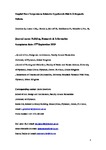Hospital Ward Temperatures Related to Hypothermic Risk in Orthopaedic Patients

Date
2019-10-15Author
Subject
Metadata
Show full item recordAbstract
This paper presents an exploration of the relationship between ward air temperature, radiative effects and hypothermic risk in elderly male orthopaedic patients admitted to a clinical ward in a university hospital. Five bed spaces have their air temperature measured alongside appropriately chosen periods of time-lapse thermography used to assess the probably mean radiative influences. Associated patient clinical data were compared with the environmental data. Because patient core temperatures were measured at different periods throughout the day, this resulted in analysis on an averaging basis allowing for trends to be identified. It was possible to identify which bed spaces with the associated patient characteristics and thermal environment were likely to influence lower than expected patient core temperatures. In conclusion, this study resulted in a null hypothesis based on the measured data and research parameters as no significant correlation between patient core body temperature and indoor air temperature could be deduced. However, this study has established a new methodology for monitoring hospital ward environments.
Collections
Publisher
Journal
Volume
Issue
Pagination
Recommended, similar items
The following license files are associated with this item:

